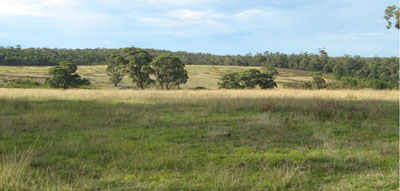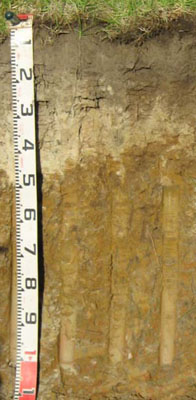EGC221
Location: Lake Tyers
Australian Soil Classification: Bleached Sodic, Magnesic, Brown KUROSOL
Map Unit: Waygara
Previous Site Name: EG221
General Landscape Description: Undulating rises
Site description: Simple upper slope 2%, north east aspect
Land Use: Grazing
Native Vegetation: Lowland forest
Geology: Neogene sediments (Late Tertiary)

Soil Profile Morphology:
| Surface soil |  | ||
A1 | 0 – 20/30 cm | Dark greyish brown (10YR4/2); sandy loam; weak medium (10 – 20 mm) polyhedral structure; firm moist; clear wavy change to: | |
A2 | 20/30 – 50/35 cm | Pale brown (10YR6/3) conspicuously bleached (10YR/8/1d); sandy loam or loamy sand; apedal, single grain; firm consistence dry; sharp change to: | |
Subsoil | |||
B21 | 50/35 – 80 cm | Yellowish brown (10YR5/6); heavy clay; moderate coarse (20 – 50 mm) polyhedral structure; strong consistence moist; diffuse change to: | |
B22 | 80 – 110 cm | Yellowish brown (10YR5/6) with greyish brown (10YR5/2) and increasing yellowish red (5YR5/6) mottles; heavy clay; moderate coarse (20 – 50 mm) lenticular structure; strong consistence moist. |
Key Profile Features:
- Strong texture contrast between the surface (A) horizons and the subsoil (B) horizons
- Conspicuously bleached subsurface (A2) horizon.
Soil Profile Characteristics:
- | pH | Salinity | ||
Surface soil (A1 horizon) | Moderately acid | Non sodic | Water stable | Nil (2 hours), Nil (20 hours) |
Subsoil (B21 horizon) | Strongly acid | Sodic | Partial | Slight (2 hours), Slight (20 hours) |
Deeper subsoil (80-110 cm) | Strongly acid | Strongly sodic | Considerable | Nil (2 hours), Nil (20 hours) |
Chemical and Physical Analysis:
Horizon | Horizon Depth (cm) | pH (water) | pH (CaCl2) | EC dS/m | Organic Carbon % | Total Nitrogen % | Exchangeable Aluminium ppm | Exchangeable Acididty meq/100g | Exchangeable Cations | Coarse Sand (0.2-2.0 mm) % | Fine Sand (0.02-0.2 mm) % | Silt (0.002-0.02 mm) % | Clay (<0.002 mm) % | Field Capacity % w/w | Wilting Point % w/w | |||
Ca | Mg | K | Na | |||||||||||||||
meq/100g | ||||||||||||||||||
A1 | 0-20/30 | 5.9 | 4.6 | 0.06 | 2.9 | 0.16 | 22 | 10.0 | 3.3 | 1.3 | 1 | 0.27 | 43 | 29 | 11 | 8 | 12.9 | 5.7 |
A2 | 20/30-50/35 | 5.3 | 4.1 | <0.05 | 0.57 | <0.05 | 74 | 3.6 | 0.51 | 0.33 | 0.15 | 0.12 | 48 | 29 | 12 | 6 | 13.9 | 3.0 |
B21 | 50/35-80 | 5.0 | 4.0 | <0.05 | 0.49 | <0.05 | 530 | 13.0 | 0.67 | 5.6 | 0.51 | 1.3 | 12 | 14 | 13 | 59 | 39.2 | 22.3 |
B22 | 80-110 | 5.4 | 4.4 | <0.05 | 0.37 | <0.05 | 110 | 8.0 | 0.21 | 9.9 | 0.32 | 3.2 | 15 | 13 | 15 | 54 | 36.5 | 20.8 |
Management Considerations
Whole Profile
- The plant available water capacity of the soil is considered to be low (estimated at 54 mm) for the top 50 cm of the soil profile.
- The dense and coarsely structured subsoil is likely to restrict root movement.
Surface (A) Horizons
- The sand surface horizons are very well draining but have a low water storage capacity. The low wilting points (i.e. 5.7 and 3.0) indicate plants will be able to utilise light rains falling on dry soil. However, due to the low water storage capacity, plants will soon suffer moisture stress unless further rain occurs. Organic matter is an important source of nutrient holding capacity as well as enhancing water holding capacity in sandy soils.
- The sandy surface soil will also be prone to wind erosion if plant cover is removed where blow-outs can occur.
- The surface horizons have a moderate inherent fertility (based on the sum of the exchangeable cations).
- The surface soil is quite high in potassium and no response to potassium fertilisers would be expected.
Subsoil (B) Horizon
- The dense and coarsely structured upper (B21) subsoil is sodic. This will restrict the downward movement of plant roots and water. The temporary build up of water on top of this less permeable layer may be beneficial for deeper-rooted plants as it prevents deep drainage of water away from plant roots.
- Sodic subsoils are typically moderately to strongly dispersive, but here are only slightly dispersive, mainly due to the high exchangeable aluminium.
- The upper (B21) subsoil has a relatively moderate inherent fertility throughout (based on the sum of the exchangeable calcium, magnesium and potassium cations). The cations are dominated by exchangeable magnesium which may create nutrient imbalances.
- The level of soluble salts is low.
Profile Described By: Heather Adams, Julieanne Sargant and Ian Sargeant, June 2009.


